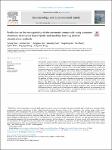Item Infomation

| Title: | Prediction on the mutagenicity of nitroaromatic compounds using quantum chemistry descriptors based QSAR and machine learning derived classification methods |
| Authors: | Sun, Guohui |
| Participants: | Hao, Yuxing Fan, Tengjiao Sun, Xiaodong Liu, Yongdong Zhang, Na Zhao, Lijiao Zhong, Rugang Peng, Yongzhen |
| Issue Date: | 2019 |
| Publisher: | Elsevier |
| Series/Report no.: | Ecotoxicology and Environmental Safety, Volume 186, 2019, 109822 |
| Abstract: | Nitroaromatic compounds (NACs) are an important type of environmental organic pollutants. However, it is lack of sufficient information relating to their potential adverse effects on human health and the environment due to the limited resources. Thus, using in silico technologies to assess their potential hazardous effects is urgent and promising. In this study, quantitative structure activity relationship (QSAR) and classification models were constructed using a set of NACs based on their mutagenicity against Salmonella typhimurium TA100 strain. For QSAR studies, DRAGON descriptors together with quantum chemistry descriptors were calculated for characterizing the detailed molecular information. Based on genetic algorithm (GA) and multiple linear regression (MLR) analyses, we screened descriptors and developed QSAR models. For classification studies, seven machine learning methods along with six molecular fingerprints were applied to develop qualitative classification models. The goodness of fitting, reliability, robustness and predictive performance of all developed models were measured by rigorous statistical validation criteria, then the best QSAR and classification models were chosen. Moreover, the QSAR models with quantum chemistry descriptors were compared to that without quantum chemistry descriptors and previously reported models. Notably, we also obtained some specific molecular properties or privileged substructures responsible for the high mutagenicity of NACs. Overall, the developed QSAR and classification models can be utilized as potential tools for rapidly predicting the mutagenicity of new or untested NACs for environmental hazard assessment and regulatory purposes, and may provide insights into the in vivo toxicity mechanisms of NACs and related compounds. |
| URI: | http://tailieuso.tlu.edu.vn/handle/DHTL/8376 |
| Source: | https://www.sciencedirect.com/science/article/abs/pii/S0147651319311534 |
| ISSN: | 0147-6513 |
| Appears in Collections: | Tài liệu hỗ trợ nghiên cứu khoa học |
ABSTRACTS VIEWS
35
VIEWS & DOWNLOAD
2
Files in This Item:
Bạn đọc là cán bộ, giáo viên, sinh viên của Trường Đại học Thuỷ Lợi cần đăng nhập để Xem trực tuyến/Tải về
Items in DSpace are protected by copyright, with all rights reserved, unless otherwise indicated.
